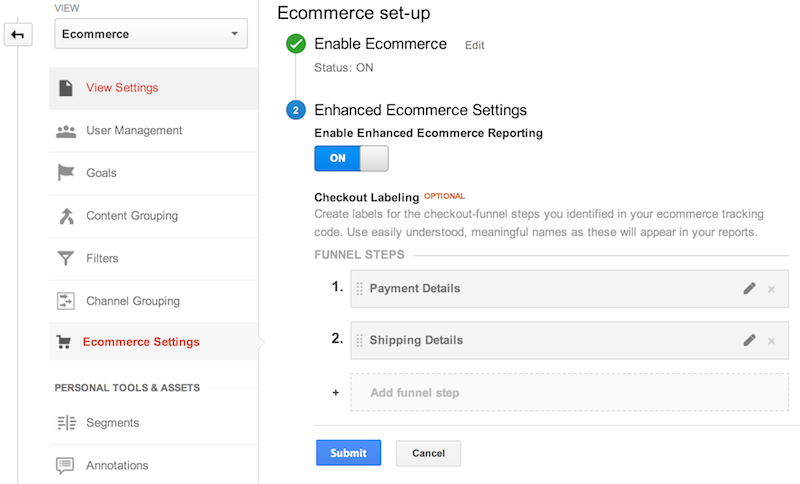Google Analytics has once again upped the ante for online retailers with a new upgrade, aptly named “Enhanced Ecommerce.” It offers deeper insights into visitor behavior. Armed with these new insights, Enhanced Ecommerce helps ecommerce businesses view traffic from a granular shopping experience and product perspective, rather than the traditional page perspective.
Enhanced Ecommerce represents a significant change in the scope of Google Analytics. It reveals new data about customer behavior and a method for measuring the effectiveness of merchandising activities, expanding Google Analytics’ scope beyond transactional data alone.

Enhanced Ecommerce helps ecommerce businesses view traffic from a granular shopping experience and product perspective.
The changes include a complete series of funnel-based reports, more support for Google Tag Manger, and the use of the Product ID dimension. Enhanced Ecommerce is now available via any standard Google Analytics account that uses Universal Analytics.
The most meaningful insights etailers can gain from Enhanced Ecommerce are as follows.
- See which products convert well and which are abandoned frequently with Product ID dimension.
- See where shoppers drop off in your shopping funnel with all new customizable funnels.
- Create data-rich user segments and dig deeper into your customers shopping experience.
- Get actionable insight into onsite promotions.
- Create custom product lists and product landing pages to measure which lists and products increase user engagement.
With the most ecommerce conversion rates at less than 3 percent, even small changes in your product strategy can yield big improvements in sales.
Customizable Funnels

Create customizable funnels in Enhanced Ecommerce.
Arguably, the most useful functionality in Enhanced Ecommerce is the ability to create customizable funnels from customer behavior within your site (combining transactions, behaviors, events and product views), to better measurement store transactional performance.
Consider cross-referencing these new funnels with traditional Google Analytics reports.
- Do your visitors drop off before registering?
- Do customers from different regions react differently when checking out?
By identifying those who abandon checkout and registration processes you can make them eligible for remarketing efforts.
Granular Product ID Dimension
Enhanced Ecommerce provides data-driven, actionable reports. For instance, you can see how many visitors viewed specific products in your store, how many added or removed a product from their shopping cart, and completed or cancelled transactions. You can track conversions at the product level, average order value, and even refund actions. Using these reports, you can uncover underperforming products and determine the best solution for improving product performance. Is the product description weak? Are the product images visually compelling? Is the pricing out of line with other online providers?
These reports show you where to best focus your energy to improve your bottom line.
Advanced reporting is also available. For instance, you can measure performance of a specific brand in your store and even develop custom reporting to fit your unique data requirements.
Ecommerce managers will also welcome Enhanced Analytics’ ability to track onsite advertising, such as the click-through rate on banner advertisements. If you participate in an affiliate network you can produce reports on traffic, transactions, and revenue generated by affiliates and coupon redemptions.
Setting up and running effective reporting has been challenging for some online retailers. Smaller companies, for example, don’t always have the budget to support a dedicated data analyst. Google has presumably recognized this, and has designed Enhanced Analytics to be easy to use, even for smaller Internet retailers with limited technical resources.
Enhanced Ecommerce includes the following new reports.
- Shopping Behavior Reports. These reports assess the performance of the entire purchase funnel. Beginning with product views, the complete user experience can be tracked. All of the reports are customizable.
- Checkout Behavior Report. This identifies the paths your visitors take through your checkout process.
- Product Performance Report. This provides a granular look at individual products and their performance in your sales funnel. There are two top level views: sales performance (i.e., quantity, revenue) and visitor behavior (i.e., product views, cart activities).
- Product List Performance Report. Savvy commerce managers have long realized the potential of onsite marketing. Now included with Enhanced Ecommerce are List Performance Reports, which enable you to measure the sales impact of grouping products together using dimensions such as Product List Position and Product List Name.
- Coupon and Affiliate Marketing Report. This enables you to track and report on transactions that include coupons and conversions as a result of affiliate marketing.
While these new report changes are useful, the new import feature is arguably the most revolutionary update. You can now import product data from your ecommerce platform directly into Google Analytics, which can significantly reduce the amount of data in each interaction.
Enhanced Ecommerce: Getting Started
To take advantage of this upgrade, there are some changes you’ll need to make.
- Tagging updates. To track these new dimensions in Enhanced Ecommerce, you’ll need to transmit them in tags or simply add the information to your data layer. For help, consult the associated guides.
- Site review. You’ll need to conduct a comprehensive review of your site from a product, rather than a page, angle. How do you group your product sets? What are the important elements in your shopping funnel?
- More meta data. In the past, merchants would simply categorize their products and add SKUs. Now they will be working with new extensions, and offered the ability to directly upload this information.
On a final note, for a comprehensive technical reference for an upgrade and migration instructions from ecommerce.js, read Google’s official Enhanced Ecommerce – Web Tracking guide.




